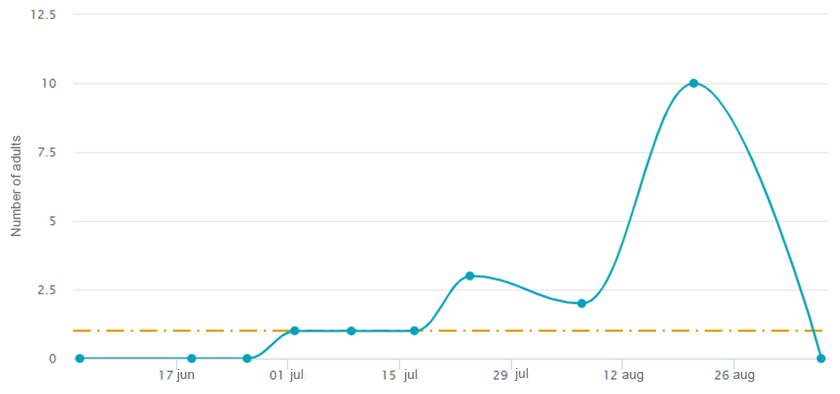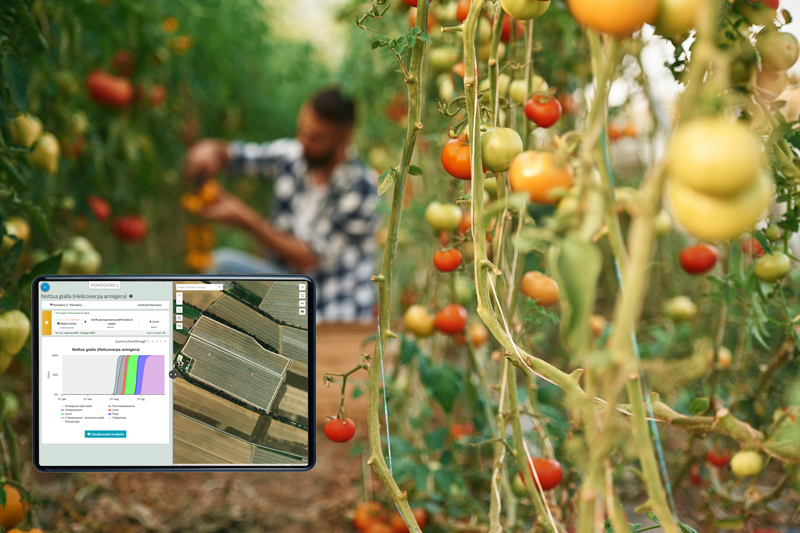The Cotton bollworm (Helicoverpa armigera) is an insect of the Lepidoptera order. It has migratory habits and a great ability to adapt to different environmental conditions: it is present, in fact, in almost all areas of the globe and it completes from 2 to 3-4 generations per year.
It prefers a warm and humid climate, which is the reason in Italy we find it mainly in the Center and South, but now it is also widespread in the North.
The Cotton bollworm is very voracious. The adults have ocher-brown front wings with greenish shades, darker in the male; the larvae, on the other hand, which cause extensive damage to flowers and fruits with their trophic activity, have very variable colors and can reach four cm in size.

Gyorgy Csoka, Hungary Forest Research Institute, Bugwood.org
The Cotton bollworm is a polyphagous insect, although it mainly affects tomatoes: we can find it on various vegetables (aubergine, pepper, salads, peas, beans), corn and tobacco.
Among AgTech tools, forecast models are of great help to farmers in protecting against this moth.
Let’s see for which crops they are present in Agricolus and how they work.
The Cotton bollworm and the tomato
The Cotton bollworm (Helicoverpa armigera) is certainly one of the most feared parasites for tomatoes: it is responsible for the common circular punctures that we often find in vegetables.
Damage can be found in all systems of the plant. The larvae, in fact, feed on leaves and flowers, causing atypical erosions; instead they dig tunnels on the fruits, consuming the pulp and passing from one fruit to another.
The Agricolus’ forecast model, specific for the defense against the Cotton bollworm, represents a useful monitoring tool relating to the climatic conditions favorable to the development of the insect to limit problems and act quickly.

In fact, it estimates the times and stages of development of the different generations of the insect.
The Cotton bollworm and the corn
The adult stage of the Cotton Bollworm (Helicoverpa armigera) appears in the month of April and has nocturnal habits. Four generations can occur in one year, while wintering takes place in the ground at the chrysalis stage.
Among the various crops affected by the Cotton Bollworm there is corn, which suffers attacks on the reproductive organs and the cobs. In this case, it is essential to keep the insect below threshold levels and monitor the presence of adults in the field.
The monitoring usually carried out with the aid of pheromone traps can be registered and managed within Agricolus: in this way it is possible to understand better and keep track of the seasonal behavior of the insect and plan any treatments.

The Cotton bollworm and the tobacco
As mentioned above, we find the Cotton Bollworm (Helicoverpa armigera) also among the harmful insects of tobacco, where it causes leaf erosion and affects the integrity of the leaf and, consequently, the quality of the tobacco.
The Agricolus’ forecast model allows for a timely defense, which is especially effective if it’s done close to the birth of the larvae. The registration of treatments can be inserted into the platform, also drawing on the Fitogest® database, so as to integrate the forecast model and reduce the indicated risk.
Agricolus is therefore the optimal solution to have a single tool for the management and defense of the multiple crops attacked by the Cotton Bollworm.






